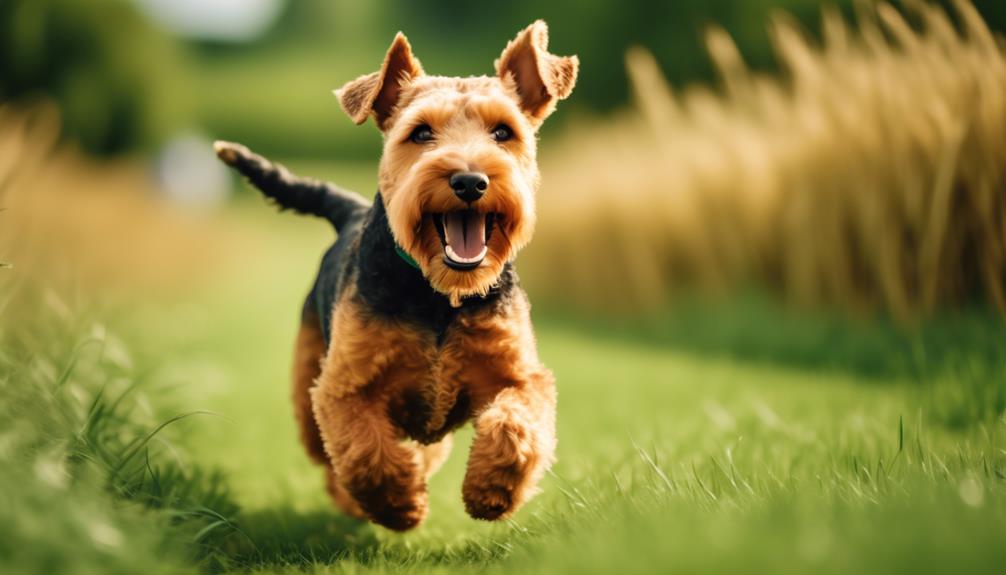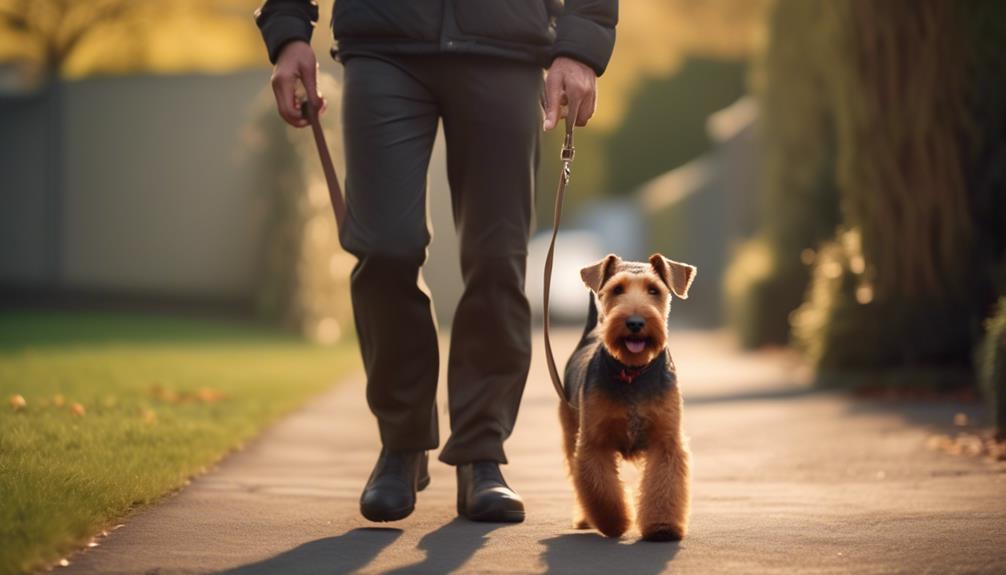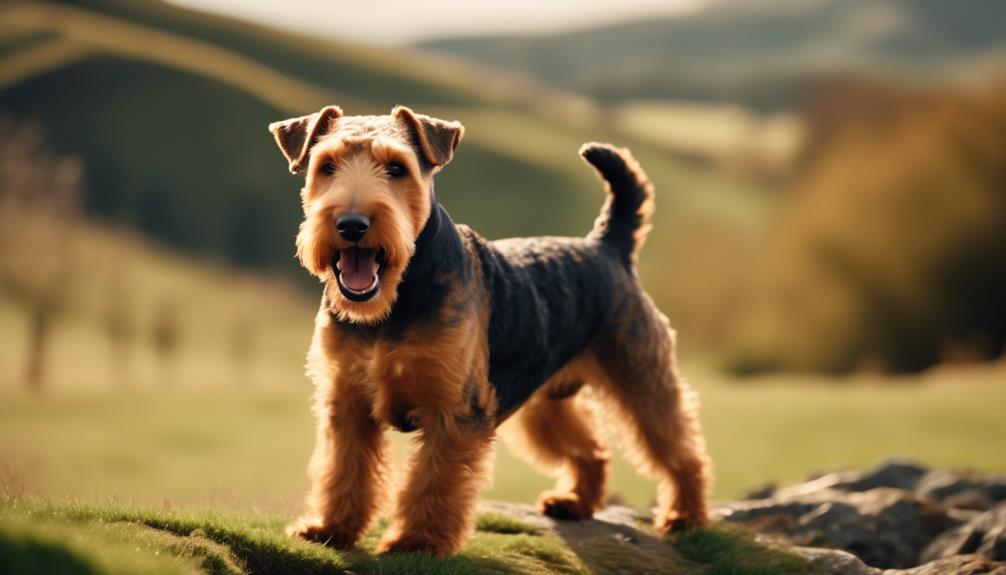
Little is known about the Welsh Terrier, a breed that often flies under the radar despite its many admirable qualities. Behind their charming appearance lies a world of fascinating characteristics and traits that make them stand out among other dog breeds.
From their historical origins to their unique temperament, there is much to discover about these delightful canines. So, if you’re eager to uncover the secrets of the Welsh Terrier and learn what makes them truly special, read on to embark on a journey of exploration and understanding.
Key Takeaways
- Welsh Terriers are medium-sized dogs with a wiry coat in shades of tan and black, known for their distinctive beard.
- They have an independent and lively temperament, but can also be affectionate and loyal.
- Welsh Terriers are generally healthy, but can be prone to genetic health issues such as hip dysplasia and skin conditions.
- When choosing a dog for apartment living, it’s important to consider factors beyond just size, such as energy levels, behavior, and the comfort of neighbors.
Origin and History
The Welsh Terrier, a medium-sized breed known for its wiry coat and distinctive beard, originated in Wales and was bred for hunting small game. With a history that dates back over two centuries, the Welsh Terrier was developed to be a versatile and hardworking hunting companion.
Its compact size and keen sense of smell made it well-suited for tracking and flushing out small game, such as foxes and badgers. Over time, the breed’s hunting skills and charming appearance gained popularity, leading to its recognition as a distinct breed.
Today, the Welsh Terrier is cherished not only for its hunting abilities but also for its friendly and affectionate nature, making it a beloved companion for families around the world.
See another Dog breed profile.
West Highland White Terrier
Size and Appearance

After exploring the origin and history of the Welsh Terrier, it’s time to shift our focus to its size and appearance.
Here are some key characteristics of the Welsh Terrier’s size and appearance:
- Size: The Welsh Terrier is a medium-sized breed, with males standing around 15.5 inches tall at the shoulder.
- Coat: This breed has a wiry and dense coat that comes in shades of tan and black. It’s known for its distinctive beard, which adds to its charming appearance.
- Body: The Welsh Terrier has a well-balanced and compact body with a deep chest and a level topline.
- Ears: Its small, V-shaped ears fold over neatly, adding to its alert and intelligent expression.
These physical attributes contribute to the overall appearance and charm of the Welsh Terrier breed.
Temperament and Personality

Exhibiting a lively and independent nature, the Welsh Terrier is known for its affectionate and loyal personality. This breed is highly devoted to its family and thrives on companionship. Welsh Terriers are generally friendly with strangers, but can be wary or reserved at times. They have a strong sense of loyalty and make excellent watchdogs. While they are affectionate and loving, they also have a stubborn streak that can make training a challenge. However, with consistent and firm guidance, Welsh Terriers can be obedient and well-behaved. They are energetic and require regular exercise to prevent boredom and destructive behavior. Overall, Welsh Terriers make wonderful companions for active individuals or families who can provide them with the attention, exercise, and mental stimulation they need.
| Personality Traits | Description |
|---|---|
| Affectionate | Welsh Terriers are known for their loving and affectionate nature towards their family members. |
| Loyal | This breed is highly devoted and loyal to their owners, making them excellent companions. |
| Independent | Welsh Terriers have an independent streak and may exhibit a strong willful nature. |
| Stubborn | They can be stubborn at times, which can make training a challenge. However, with consistent and firm guidance, they can be obedient and well-behaved. |
Health and Genetic Issues

Moving on to the topic of health and genetic issues, it’s important to be aware of any potential concerns that may affect Welsh Terriers. Here are some key points to keep in mind:
- Hip Dysplasia: This is a common genetic condition in Welsh Terriers. It occurs when the hip joint doesn’t develop properly, leading to pain and mobility issues.
- Skin Conditions: Welsh Terriers are prone to various skin conditions, such as allergies and dermatitis. Regular grooming and proper hygiene can help prevent and manage these issues.
- Eye Problems: Cataracts and glaucoma are among the eye problems that can affect Welsh Terriers. Regular eye examinations by a veterinarian are essential for early detection and treatment.
- Hypothyroidism: This is a hormonal disorder that can affect Welsh Terriers. It can cause weight gain, lethargy, and skin problems. Regular blood tests can help diagnose and manage this condition.
Adaptability for Apartment Living

Welsh Terriers are well-suited for apartment living due to their adaptability and moderate size. These dogs can easily adjust to living in smaller spaces, making them a great choice for apartment dwellers. To add a level of sophistication to the discussion, here is a table outlining the factors to consider when choosing a dog for an apartment:
| Factors to Consider | Recommendation |
|---|---|
| Size | Not the sole determinant, consider energy levels and space requirements |
| Noise Levels | Choose a dog that doesn’t excessively bark |
| Energy Levels | Prioritize low-energy dogs |
| Neighbor Comfort | Consider the impact on neighbors and select a dog with polite behavior |
| High-rise Living | Small dogs with high energy levels may not be ideal for apartments |
Factors to Consider for Apartment Dogs

When selecting a dog for an apartment, it’s important to consider various factors to ensure a harmonious living environment. Here are some key factors to consider:
- Size alone shouldn’t be the sole determinant; energy levels and space requirements should also be taken into account.
- Prioritize qualities such as being quiet, low-energy, calm indoors, and having good manners.
- Consider the comfort of your neighbors when selecting a dog for an apartment; choose a pet that doesn’t excessively bark.
- Certain small dog breeds with higher energy levels can still thrive in apartments, so don’t dismiss them solely based on size.
Characteristics of Welsh Terriers

With their all-around friendliness and adaptability, Welsh Terriers make excellent companions for families and individuals alike. These dogs are known for their affectionate nature towards their family members and their ability to get along well with novice owners. Welsh Terriers are generally low-sensitivity dogs who can tolerate being alone for moderate periods of time. They’re also adaptable to different weather conditions, including both hot and cold climates.
However, it’s important to note that Welsh Terriers can exhibit aggression, which is often rooted in fear and anxiety. Proper training and socialization from an early age can help manage and prevent aggressive behavior.
Additionally, Welsh Terriers have varying levels of tendency to bark or howl, so it’s important to consider noise restrictions and the living environment when considering this breed.
Aggression and Fear Management

Managing aggression and fear in Welsh Terriers requires proper training and socialization from an early age. To effectively manage these behaviors, owners should consider the following:
- Consistent and positive reinforcement training techniques: Use rewards and praise to encourage desired behaviors and discourage aggressive or fearful reactions.
- Early and ongoing socialization: Expose your Welsh Terrier to various people, animals, and environments to help them become confident and well-adjusted.
- Recognize and address triggers: Identify situations or stimuli that may trigger aggression or fear, and work on desensitizing your dog through gradual exposure and counterconditioning.
- Seek professional help if needed: If your Welsh Terrier’s aggression or fear becomes uncontrollable or poses a danger, consult with a certified dog trainer or behaviorist for guidance and assistance.
Barking and Howling Behavior

To address another important aspect of Welsh Terrier behavior, it’s essential to explore their tendency towards barking and howling.
Welsh Terriers are known to be vocal dogs and may bark to communicate various things, such as alerting their owners to potential threats or expressing their excitement. However, excessive barking can become a nuisance, especially in apartment settings where noise restrictions may be in place.
It’s important for owners to address this behavior early on through proper training and socialization. Providing mental and physical stimulation can also help reduce barking tendencies. While Welsh Terriers may have a natural inclination to vocalize, with proper guidance and attention, their barking can be managed effectively.
Wanderlust Potential and Containment

Welsh Terriers have a natural propensity for exploring their surroundings, making it important to provide appropriate containment measures. To ensure the safety and well-being of these adventurous dogs, owners should consider the following:
- Secure Fencing: Welsh Terriers are known for their digging abilities, so it’s crucial to have a fence that’s both tall and buried deep enough to prevent escapes.
- Leash Training: Consistent leash training is essential to prevent wandering and keep the Welsh Terrier by your side during walks and outings.
- Supervision: Keeping a close eye on your Welsh Terrier is vital, especially in unfenced areas. Their wanderlust can lead them to explore beyond their boundaries.
- Mental Stimulation: Providing ample mental stimulation through interactive toys, puzzles, and training can help reduce their desire to wander and keep them mentally satisfied.
Care and Maintenance Tips

After discussing the importance of containment measures for Welsh Terriers’ wanderlust potential, it’s essential to understand the care and maintenance tips for keeping these adventurous dogs happy and healthy.
Welsh Terriers require a minimum of 30 to 60 minutes of daily exercise to keep them physically and mentally stimulated. This can be achieved through various activities such as walks, runs, and playtime.
When it comes to feeding, the recommended daily amount depends on the dog’s size, age, metabolism, and activity level.
Welsh Terriers have a wiry coat in shades of tan and black, which requires regular brushing to prevent matting. Occasional stripping may also be necessary to maintain the coat’s texture.
While they can be patient with children, it’s important to supervise interactions with other pets as Welsh Terriers may display dog-aggression if not properly socialized.
It’s also recommended to seek resources from Welsh Terrier rescue groups and breed organizations for adoption and fostering, as well as finding a reputable breeder.
Frequently Asked Questions
Are Welsh Terriers Good With Children?
Welsh Terriers can be good with children, but supervision is recommended. Proper socialization and training are important to ensure a positive interaction. It is also crucial to supervise interactions with other pets, as Welsh Terriers may display dog-aggressive behavior if not properly socialized.
How Much Exercise Does a Welsh Terrier Need?
A Welsh Terrier needs a minimum of 30 to 60 minutes of daily exercise. Activities like walks, playtime, and mental stimulation are important to keep this lively breed happy and healthy.
Do Welsh Terriers Get Along With Other Pets?
Welsh Terriers generally get along well with other pets if properly socialized. However, they may exhibit dog-aggressive behavior if not. It’s important to supervise interactions and prioritize proper socialization to ensure a harmonious relationship with other animals.
Can Welsh Terriers Be Left Alone for Long Periods of Time?
Yes, Welsh Terriers can be left alone for moderate periods of time. However, they may become anxious or develop behavioral issues if left alone for extended periods. It’s important to provide them with mental stimulation and exercise.
Are Welsh Terriers Prone to Separation Anxiety?
Welsh Terriers can be prone to separation anxiety if not properly trained and socialized. It is important for owners to gradually acclimate them to being alone and provide mental stimulation to prevent anxiety behaviors.
Conclusion
In conclusion, the Welsh Terrier is a versatile and charming breed that makes an excellent companion for families and individuals alike. With their distinctive appearance and affectionate nature, they’re sure to bring joy to any home.
While they may have specific exercise and grooming needs, their adaptability to apartment living and compatibility with children and other pets make them a popular choice for many.
With the right care and attention, the Welsh Terrier can thrive and bring years of happiness to their owners.




